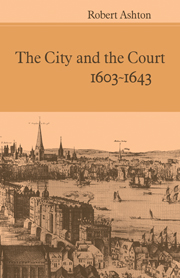Book contents
- Frontmatter
- Contents
- List of tables
- Preface and acknowledgements
- Note on dating, spelling and abbreviations
- Introduction
- 1 Institutions and oligarchy I: the municipal and business élites
- 2 Institutions and oligarchy II: gilds and companies
- 3 Big business and politics under James I
- 4 Big business and politics under Charles I
- 5 The crown and the municipality: local issues
- 6 The municipality and national issues
- 7 Conclusion
- Sources and bibliography
- Index
2 - Institutions and oligarchy II: gilds and companies
Published online by Cambridge University Press: 07 October 2011
- Frontmatter
- Contents
- List of tables
- Preface and acknowledgements
- Note on dating, spelling and abbreviations
- Introduction
- 1 Institutions and oligarchy I: the municipal and business élites
- 2 Institutions and oligarchy II: gilds and companies
- 3 Big business and politics under James I
- 4 Big business and politics under Charles I
- 5 The crown and the municipality: local issues
- 6 The municipality and national issues
- 7 Conclusion
- Sources and bibliography
- Index
Summary
The London livery company which emerged out of the medieval gild in the course of the later Middle Ages has been described by the greatest of its historians as ‘a social hierarchy … organized on the principle of selection from above’. Unwin's definition clearly implies that membership of the company did not necessarily confer equal rights upon all of its members. A convenient starting point for illustrating the oligarchical tendencies within the livery company is the institutional bifurcation of that body into an upper section, usually known as the livery, and a lower, usually known as the yeomanry. The distinction corresponds roughly with that between those who exercised trade in the products of a craft or crafts and those who manufactured them. The livery consisted of the more affluent members of the society, and since the surest way to affluence in pre-industrial England lay via the pursuit of trade rather than the exercise of a craft, it was inevitable that, at least in the case of the greater companies, the vast bulk of the members of the livery were traders rather than craftsmen. The conflict within the ranks of the livery company with which Unwin was especially concerned was that between tradesmen and craftsmen or, in other words, between livery and yeomanry. But discussion of the oligarchical tendencies which characterized the London livery companies is by no means exhausted by reference to this conflict and its institutional expression.
- Type
- Chapter
- Information
- The City and the Court 1603-1643 , pp. 43 - 82Publisher: Cambridge University PressPrint publication year: 1979

